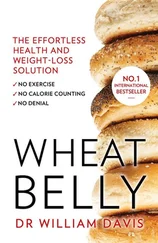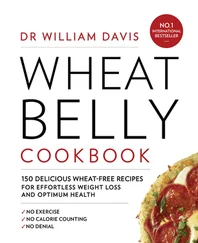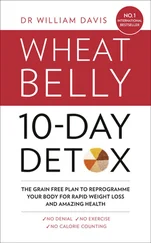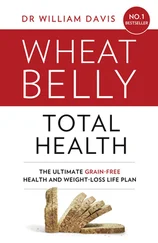After three months, my patients returned to have more blood work done. As I had anticipated, with only rare exceptions, blood sugar (glucose) had indeed often dropped from diabetic range (126 mg/dl or greater) to normal. Yes, diabetics became non- diabetics. That’s right: Diabetes in most cases can be cured—not simply managed—by removal of carbohydrates, especially wheat, from the diet, with the odds further stacked in your favor by correcting a few common nutrient deficiencies. Many of my patients also lost 20, 30, even 40 pounds, even when I didn’t tell them that they would slim down—yes: weight loss by “accident.”
But it’s what I didn’t expect that astounded me.
They reported that symptoms of acid reflux disappeared and the cyclic cramping and diarrhea of irritable bowel syndrome were gone, typically within five days, eliminating the need for mad rushes to the toilet. Energy improved, focus was greater, sleep was deeper. Rashes disappeared, even rashes that had been present for years. Rheumatoid arthritis pain improved or disappeared over several weeks, enabling them to cut back, even eliminate, the nasty medications used to treat it. Joint pains in the hands, wrists, and elbows disappeared within a week. Anxiety, dark moods, even suicidal thoughts miraculously receded. Asthma symptoms improved or resolved completely, allowing many to throw away their inhalers. Athletes reported more consistent performance.
Thinner. More energetic. Clearer thinking. Better bowel, joint, and lung health. Time and time again. Surely these results were reason enough to forgo wheat.
What convinced me further were the many instances in which people removed wheat, then permitted themselves a wheat indulgence: a couple of pretzels, a canapé at a cocktail party, a slice of birthday cake—“What the heck? It’s my daughter’s birthday. A few bites can’t hurt!” Within minutes, most would experience diarrhea, abdominal discomfort, bloating, joint swelling and pain, wheezing, anxiety, even anger. On again, off again, the phenomenon would repeat itself.
What started out as a simple experiment in reducing blood sugars exploded into an insight into multiple health conditions and weight loss that continues to amaze me even today.
A RADICAL WHEAT-ECTOMY
For many, the idea of removing wheat from the diet is, at least psychologically, as discomforting as the thought of having a root canal without anesthesia. For some, the process can indeed have uncomfortable side effects akin to withdrawal from cigarettes or alcohol. But this procedure must be performed to permit the patient to recover.
Wheat Belly explores the proposition that the health problems of Americans, from fatigue to arthritis to gastrointestinal distress to obesity, originate with the innocent-looking bran muffin or cinnamon raisin bagel you down with your coffee every morning.
The good news: There is a cure for this condition called wheat belly—or, if you prefer, pretzel brain, bagel bowel, or biscuit face.
The bottom line: Elimination of this food, part of human culture for more centuries than Larry King was on the air, will make you sleeker, smarter, faster, and happier. Weight loss, in particular, can proceed at a pace you didn’t think possible. And you can selectively lose the most visible, insulin-opposing, diabetes-creating, inflammation-producing, embarrassment-causing fat: belly fat. It is a process accomplished with virtually no hunger or deprivation, with an astonishing spectrum of health benefits. And, because this lifestyle rapidly reverses the inflammation caused by wheat, within days to weeks you will find that facial appearance is transformed, sufficient for people around you to ask if you’ve undergone radical plastic surgery—no kidding. (Consider taking before/after “selfies” to prove it.)
I suspect that, once you experience the wonderful health and weight liberation that develops by banishing this problematic group of foods, you may be eager to explore even greater heights of health. I will, therefore, discuss why you should take steps to correct the nutritional deficiencies caused or worsened by prior grain consumption, as well as a few other common nutritional deficiencies. This is like the physical therapy that you undergo after surgery, the steps you can take to get back to the dance floor and dance your dietary version of the boogie-woogie.
The next chapterwill explain why wheat has a unique ability to convert quickly to blood sugar. In addition, it has addictive properties that actually cause us to overeat; has been linked to literally dozens of debilitating ailments beyond those associated with being overweight; and has infiltrated almost every aspect of our diet. Sure, cutting out refined sugar is a good idea, as it provides little or no nutritional benefit and impacts your blood sugar in a negative way. But eliminating wheat is the easiest and most effective step, the biggest bang for your buck that you can take to safeguard your health and trim your waistline.
CHAPTER 2
NOT YOUR GRANDMA’S MUFFINS: THE CREATION OF MODERN WHEAT
He is as good as good bread.
—MIGUEL DE CERVANTES, DON QUIXOTE
WHEAT, MORE THAN any other foodstuff, is woven into the fabric of the American food experience, a trend that began even before Ozzie met Harriet. It has become such a ubiquitous part of the American diet in so many ways that it seems essential to our lives. What would a plate of fried eggs be without toast, lunch without sandwiches, beer without pretzels, picnics without hot dog buns, dip without crackers, hummus without pita, lox without bagels, apple pie without crust?
IF IT’S TUESDAY, IT MUST BE WHEAT
I measured the length of the bread aisle at my local supermarket: sixty-eight feet.
That’s sixty-eight feet of white bread, whole wheat bread, multi-grain bread, seven-grain bread, rye bread, pumpernickel bread, sourdough bread, Italian bread, French bread, breadsticks, white bagels, raisin bagels, cheese bagels, garlic bagels, oat bread, flax bread, pita bread, dinner rolls, Kaiser rolls, poppy seed rolls, hamburger buns, and fourteen varieties of hot dog buns. That’s not even counting the bakery and the additional forty feet of shelves packed with a variety of “artisanal” wheat products.
And then there’s the snack aisle with forty-some brands of crackers and twenty-seven brands of pretzels. The baking aisle has bread crumbs and croutons. The dairy case has dozens of those tubes you crack open to bake rolls, Danish, and crescents.
Breakfast cereals fill a world unto themselves, usually enjoying a monopoly over an entire supermarket aisle, top to bottom shelves.
There’s much of an aisle devoted to boxes and bags of pasta and noodles: spaghetti, lasagna, penne, elbows, shells, whole wheat pasta, green spinach pasta, orange tomato pasta, egg noodles, tiny-grained couscous to three-inch-wide pasta sheets.
How about frozen foods? The freezer has hundreds of noodle, pasta, and wheat-containing side dishes to accompany the meat loaf and roast beef au jus.
In fact, apart from the detergent and soap aisle, there’s barely a shelf that doesn’t contain wheat products. Can you blame Americans if they’ve allowed wheat to dominate their diets? After all, it’s in practically everything from Twizzlers to Twinkies to twelve-grain bread.
Wheat as a crop has succeeded on an unprecedented scale, exceeded only by its cousin, corn, in acreage of farmland planted. It is, by a long stretch, among the most consumed foods on earth, constituting 20 percent of all human calories. While humans also consume plenty of corn in its widely varied forms, from corn on the cob to high-fructose corn syrup and maltodextrin, much of the corn is also fed to livestock to fatten them up and marble the meat just before slaughter.
Читать дальше












